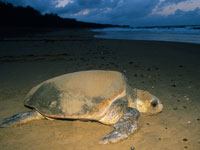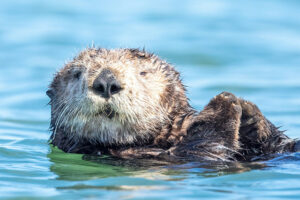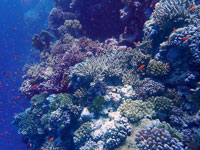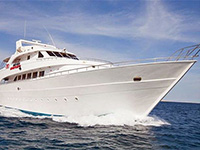Reviews: "Love the newsletters! Keep them coming" Janice Fleming...MORE REVIEWS

SCUBA News 286
(ISSN 1476-8011)
May 2024
~~~~~~~~~~~~~~~~~~~~~~~~~~~~
SCUBA News (ISSN 1476-8011)
Issue 286 - May 2024
https://www.scubatravel.co.uk
~~~~~~~~~~~~~~~~~~~~~~~~~~~~~
Welcome to SCUBA News. This month I feature the Giant Moray Eel, common around the Indo-Pacific. There is also 20% off my all time favourite liveaboard, the Duyung Baru.
Any questions, reviews or comments to news@scubatravel.co.uk.
Contents:
What's new at SCUBA Travel?
Giant Moray Eel, large but only dangerous when provoked
9 Fantastic Liveaboard Deals: Save up to 30%!
Diving news from around the World
What's New at SCUBA Travel?
 |
Malaysia is home to one of the most famous dive sites in the World: Sipadan. But is it the best Malaysia has to offer?
|
 |
Picturesque diving in Portugal On the migration route for loggerhead and leatherback turtles, mainland Portugal has some lovely diving.
|
 |
California's Underwater Paradise: Diving the Pacific Coast With over 3,000 miles (4828 km) of coastline to explore, California is truly an avid diver's paradise. From kelp forests to wrecks and exceptional sealife everywhere.
|
10 Fantastic Liveaboard Deals - Save up to $800
More great liveaboard diving deals, specially selected for us by Divebooker.com, the liveaboard specialists. Including the fabulous Komodo diving on the Duyung Baru, the best dive boat I've ever been on. But hurry, some of these offers need to be booked in May.
- Duyung Baru, Komodo. Price from $2475 $1980 per trip per person, SAVE 20% in July and August. You'll take in the world class dive sites of Batu Bolong, Crystal Rock, Castle Rock and more. A lovely traditional liveaboard with just 8 guests - you'll often be the only divers on the dive site. Bliss.
- Valentina, Sea of Cortez, 3-9 Aug and 7-13 September 2024, SAVE $100, Price from USD 2840 2740 per trip per person. Book by end of May.
- Mantamae, Komodo - Bali, 18 - 27 July 2024 (9 nights), Price from EUR 3870 2709 per trip per person, SAVE 30%. Starting at Labuan Bajo for Komodo, and finishing the trip in Bali.
-
Raja Ampat Aggressor, Lembeh / North Sulawesi / Derawan: 26 Aug - 07 September 2024 (12 nights). Book now and save $800 per person
- Seadoors, Philippines, 5-21 June and 29 June - 5 July 2024 SAVE 20%, Price from USD 2860 2288 per trip per person. Tubbataha is renowned for its exceptional biodiversity, with over 600 species of fish, 360 species of coral, sharks, rays, turtles and other pelagic species. You'll visit top dive sites like Jessie Beazley Reef known for stunning coral gardens and shark encounters and the Malayan Wreck.
- Scubaspa Yin, Best of Maldives, 16-23 Nov and 14-21 December 2024 SAVE 11%, Price from USD 3550 3159 per trip per person.
-
Mola Mola 2, Komodo, 4-10 July 2024, SAVE 15% on diving Tubbataha
- Bahamas Aggressor, Exuma Cays and Southwest Eleuthera, 27 July - 03 Aug 2024 (7 nights), SAVE $700, Price from USD 3,195 2,495 per trip per person *Specials do not apply to group reservations
- Emperor Harmoni, Best of Raja Ampat, 5 - 14 September 2024 (9 nights), Price from EUR 4,455 3,564 per trip per person, SAVE Euro 891
- Mantamae, Komodo - Bali, 18 - 27 July 2024 (9 nights), Price from EUR 3870 2709 per trip per person, SAVE 30%. Starting at Labuan Bajo for Komodo, and finishing the trip in Bali. With just 10 divers per trip.
-
Sea Serpent Excellence, St. Johns, Red Sea. Experience some of the best diving the Red Sea has to offer from 27 June - 4 July and 11 - 18 July 2024, SAVE 19%, Price from EUR 1474 1200 per trip per person
Giant Moray Eel, large but only dangerous when provoked
Our Creature of the Month today is the the Giant Moray Eel, Gymnothorax javanicus

The largest of the moray eels, growing up to 3 m and the biggest encountered reaching a weight of 30 kg. Common throughout the Indo-Pacific, including the Red Sea.
Are Giant Morays Dangerous?
Although large, they are not normally dangerous to divers. But they are powerful fish with sharp teeth that can inflict serious wounds if provoked.
The famous Marine biologist John E Randall, writing in Australian Natural History recounts.
"The man was spearing a large moray eel for the Marine Toxins Program of the Hawaii Institute of Marine Biology. He followed a policy of spearing an eel and then returning to the boat for about 15 minutes...One good-sized eel was apparently little affected, for it extricated itself from the spear and bit the man in the shoulder.

Can you eat them?
No! They cause ciguatera fish poisoning. Ciguatoxin occurs in dinoflagellites, small organisms which stick to coral and algae. These are consumed by herbivorous fish. The fish in turn are eaten by larger fish and the toxin becomes more and more concentrated up the food chain until it reaches the giant moray eel. Once thought to be confined to the South Pacific and Caribbean, the toxin was recently isolated in the Red Sea and the Atlantic Ocean.

Symptoms of ciguatera toxicity include nausea, vomiting, diarrhea, headaches, muscle aches, numbness, vertigo, metallic taste in the mouth, blurred vision and hallucinations. Severe ciguatera toxicity can cause a feeling of a burning sensation on coming in contact with a cold object. Signs and symptoms can last from weeks to year and a relapse may be triggered by consuming alcohol, nuts, seeds, fish, chicken or eggs.
Co-operation between Giant Morays and other fish

The eel is being cleaned by a Bluestripe Cleaner wrasse (Labroides dimidiatus). It is eating parasites and dead tissue off the eel's skin. This keeps the eel's skin healthy whilst providing a meal for the wrasse. It's helpful cleaning duties give it protection from being eaten by the larger fish. An example of mutualism.

Giant morays also hunt with grouper. The grouper signals to the moray eel to start a joint search for prey, and recruits the eel to a prey hiding places. This works for both fish as they have complementary hunting skills
Normally grouper hunt during the day and giant morays during the night. Grouper hunt in midwater, so prey fish hide in crevices in the coral. Morays, though, squeeze through holes in the reef to corner their prey, which they locate with their excellent sense of smell. Consequently fish swim into open water to avoid them. When the grouper and the moray work together though, they are very difficult to evade.

A hungry grouper will seek out a giant moray and hover in front of it, shaking its head. The moray joins it and the hunt begins.
This behaviour lets the grouper catch five times as many fish as on its own. The moray caught even more fish than the grouper.
Lifestyle of Giant Morays
Morays undergo a sex change during growth, changing from male to female.

They feed primarily on fish, occasionally on crustaceans and octopus. You may see giant morays rhythmically opening and closing their mouths. They do this to maintain a respiratory current past the gills.

Giant moray eels are fascinating creatures with a complex social life and surprising hunting strategies. While their large size might seem intimidating, they generally pose no threat to scuba divers as long as proper respect is maintained. These underwater residents play an important role in the reef ecosystem, and understanding their behaviour helps us appreciate the delicate balance of life within the coral world.
References
Traylor J, Singhal M. Ciguatera Toxicity. [Updated 2023 Jun 26]. In: StatPearls [Internet]. Treasure Island (FL): StatPearls Publishing; 2024 Jan.
Randall, J.E. 1969. How Dangerous is the Moray Eel? Australian Natural History. June 1969: 177-182.
Bshary R, et al. Interspecific communicative and coordinated hunting between groupers and giant moray eels in the Red Sea. PLoS Biol. 2006 Dec;4(12):e431.
Diving news from around the World
 |
The best place to dive in June?
|
 |
Unveiling the lionfish invasion in the Mediterranean Sea
|

|
Discovered: New Nursery Area for Smooth Hammerhead Sharks in Galapagos
|

|
Stony coral tissue loss disease is shifting the ecological balance of Caribbean reefs
|

|
Fish deaths in England's rivers rise tenfold in four years
|

|
A rise in sea urchins and related damage to kelp forests impacts grey whales and their food
|
 |
After hundreds of years, study confirms Bermuda now home to Cownose Rays
|
 |
Rapid Oyster Reef Restoration Gives Hope for Repairing the Sea
|
 |
Why are whales pooing on orcas?
|
 |
Saudi Arabia attempts to buy Red Sea resort in Egypt
|
SCUBA News is licensed under a Creative Commons Attribution 4.0 Unported License. This means we are happy for you to reuse our material for both commercial and non-commercial use as long as you: credit the name of the author, link back to the SCUBA Travel website and say if you have made any changes. Most photos though, are copyright the photographer. Please get in touch for details.
Photo credits: Diego Grandi, Tatiana Ivkovich, Steven Redmond, Andrea Izzotti/DepositPhotos, Tim Nicholson, Jill Studholme, Garry Frazer, Albrecht Fischer
UNSUBSCRIBING
Visit {?$optout_link?} to remove yourself from the mailing list. Any problems
contact news@scubatravel.co.uk.
ADVERTISING
Should you wish to advertise in SCUBA News, please
see the special offers at
https://www.scubatravel.co.uk/newsad.html
Other advertising opportunities are at
https://www.scubatravel.co.uk/diving-advertising.html
CONTACTING THE EDITOR
Please send your letters or press releases to:
Jill Studholme
SCUBA News
The Cliff
DE6 2HR
UK
news@scubatravel.co.uk
SCUBA News (ISSN 1476-8011)
Every month we send out a free newsletter featuring the best diving areas, underwater life, diving book reviews and interviews with authors. To receive this please fill in your e-mail address below. For an archive of previous issues see the SCUBA News page.








